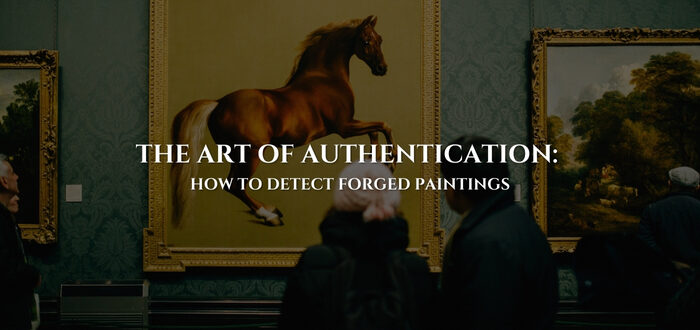How To Detect Forged Paintings
Sergei Bongart, a Ukrainian painter, famously said “Once you set out to copy another painter you can never be more than number two
Art has always been a realm where creativity, beauty, and history converge.
The digital era has changed the art world forever with new mediums, increased access to audiences, and innovative platforms for art transactions. But with the good comes the bad. Unfortunately, art forgers and those who sell them have been quick to pounce on the opportunities that the digital realm provides for their nefarious activities. As more valuable works of art circulate in global markets, buyers, collectors, and institutions face the ongoing challenge of determining authenticity. Understanding the methods of art and painting authentication and how to spot forgeries has become an essential skill for anyone involved in the world of art.
The Importance of Art Authentication
Stepping into the art world can be like exploring a captivating narrative. Authenticity is a crucial factor in appraising art, particularly for collectors and enthusiasts. This article simplifies the process of determining a piece’s originality.
Art authentication refers to the process of verifying the legitimacy and origin of a work of art. Given that many artworks, particularly from famous artists, command high prices, forgers attempt to create convincing replicas or falsify lesser-known works to pass them off as originals. A single forged painting could sell for millions, leading to substantial financial losses and tarnished reputations for collectors and galleries. Beyond the monetary impact, art forgery can distort history. Understanding and practicing art authentication is therefore vital not just for preserving financial value but for safeguarding art history.
Mark your calendar: 14-15 October
Common Types of Art Forgery
Before diving into methods of authentication, it’s essential to understand the types of art forgery that occur. Forgers employ various tactics to deceive buyers and institutions:
- Direct Copies: These forgeries involve copying an existing artwork, often of famous pieces.
- Misattribution: Sometimes, forgers take lesser-known works from obscure artists and falsely attribute them to well-known painters.
- Falsified Provenance: Provenance is the documented history of ownership of an artwork. Some forgers fabricate documents or stories that falsely claim a piece has an illustrious history, making it appear more valuable.
So, how can you ensure a painting is the real deal before buying?
Key Steps in Art Authentication
Research The Artist
If you are an art connoisseur, you most certainly would want to invest in a painting that is produced by a famous artist. Right? So, check on the work done by this artist in the past. You will notice his trademark style. Now check on the painting you are about to buy. Is it fit to be a part of the artist’s series? Is there a surprise element? If yes, be cautious. It could just be an ordinary painting being passed off as one created by a well-known artist.
Verify Signatures
Look for the artist’s signature or any distinctive markings that may indicate the piece’s authenticity. Keep in mind that some artists may not sign their work, so the absence of a signature does not necessarily mean the piece is not original.
Provenance Research
Provenance is the history of ownership and transaction of a particular piece. A well-documented provenance provides a paper trail showing how the work has been transferred through different collectors and galleries over the years. To verify provenance, researchers look for: Historical records, sales receipt, transfer certificate or other corresponding legal documents
Brush Bristles
A cheap replica will speak for itself. Take a closer look at the painting. You will notice the brush bristles stuck on to it. This is one of the most common ways to check on the authenticity of the painting. An original piece of art will not have any traces of brush bristles for you to see.
Old is Gold
When it comes to a painting, it most certainly is. The older essence of the frame, the canvas, the paint…all of them shall speak to you. If it is a new painting, you will be able to smell the freshness of the paint.
Get the Painting Appraised
If there is a lot of money involved then don’t settle on options that help you judge the work yourself. Get an expert to do the needful. But make sure that the appraiser you get in touch with is certified to do so
Carbon Dating
In some cases, radiocarbon dating is used to estimate the age of materials, such as canvas or wooden panels, to determine if they align with the period when the artist was active. This method is particularly useful for older paintings where other techniques may not provide conclusive evidence.
Discover the perfect festive gifts
Authenticity Certificate
A Certificate of Authenticity is a signed document proving the authenticity of the work and containing details about the artwork. The authenticity of artwork means that the origin of the work of art has been correctly identified. Artwork without a certificate could be fake and should not be purchased.
Red Flags and How to Spot a Forged Painting
While authentication is often left to experts, there are some red flags that anyone, including casual buyers, can look out for when examining a painting. Here are a few tips to help you spot a potential forgery:
Inconsistent Provenance: If the history of ownership is murky, incomplete, or seems too good to be true, it could be a sign of a forged painting.
Too-Perfect Condition: Old paintings usually show signs of wear, fading, or other effects of aging. If the piece looks suspiciously new, it might be a fake.
Signature Placement and Style: Compare the signature on the painting to known examples of the artist’s signature. Look for differences in handwriting style, pressure, and placement.
Unusual Materials: If you know that the artist primarily worked with a specific type of canvas, wood, or pigment, be wary if the piece uses unusual or anachronistic materials.
Suspicious Pricing: If an artwork is priced significantly below market value for an original piece by a renowned artist, it’s worth investigating further.
Conclusion
Whether you’re an art collector, a gallery owner, or an enthusiast, knowing how to spot a forgery is a valuable skill that will enhance your appreciation and understanding of the art world. As technology continues to evolve, so will our ability to protect the authenticity and legacy of great art.
Masterpieces Under the Hammer
Join us on 14-15 October at the Giftex Modern & Contemporary Art Auction, where history meets the present in an extraordinary collection of famous works from renowned artists like Jamini Roy, F N Souza, M F Husain, and more. Don’t miss your chance to own a piece of art history! This exclusive event offers a rare opportunity to acquire works that inspire and captivate.






